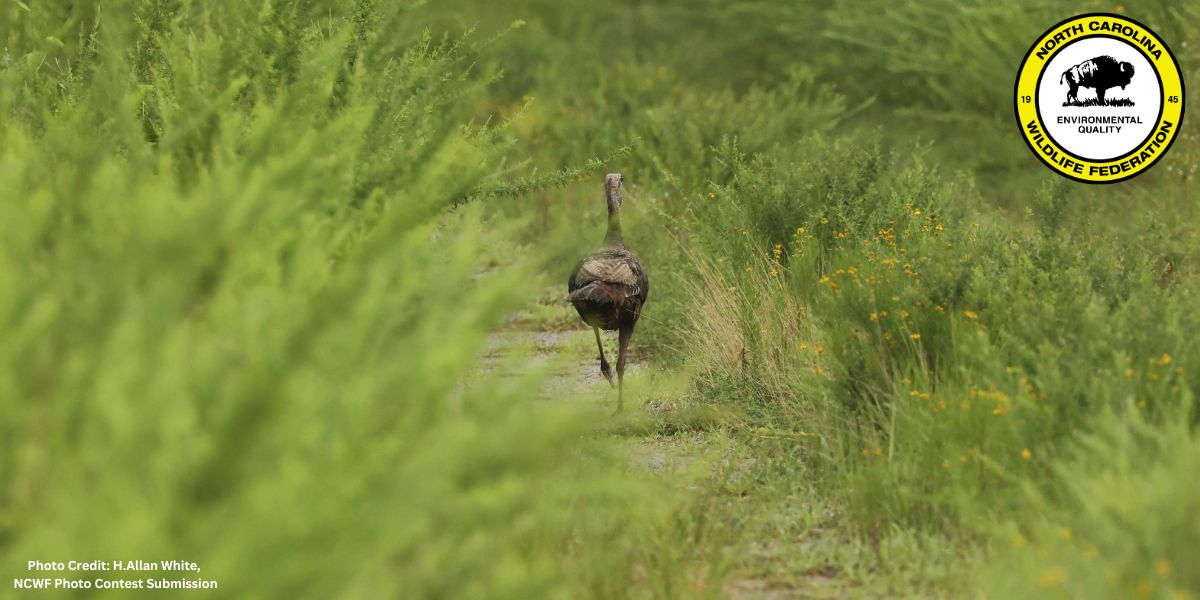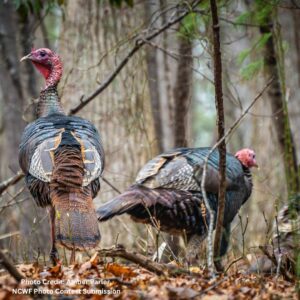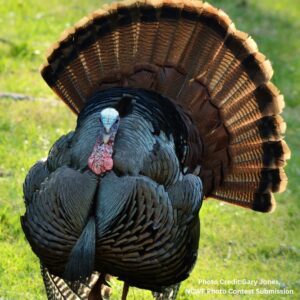North Carolina Wild Turkeys – Wildlife in the Overstory 2024 Revised Edition

What do you know about wild turkeys and their treetop roosting habits?
“For the Truth the Turkey is in Comparison a much more respectable Bird [than the bald eagle], and withal a true original Native of America… He is besides, though a little vain & silly, a Bird of Courage.” -Benjamin Franklin
 It has long been thought that Benjamin Franklin advocated for and promoted the wild turkey (Meleagris gallopavo) as the national bird of the United States rather than the bald eagle. While most experts say that this is probably a myth, it is sure that Franklin did have great admiration for the bird, as indicated by the quote above, sourced from a letter written to his daughter.
It has long been thought that Benjamin Franklin advocated for and promoted the wild turkey (Meleagris gallopavo) as the national bird of the United States rather than the bald eagle. While most experts say that this is probably a myth, it is sure that Franklin did have great admiration for the bird, as indicated by the quote above, sourced from a letter written to his daughter.
While the wild turkey may not have made it to the grand status of the national bird, it without a doubt provides a spectacle of grandeur to anyone who lays eyes on it. And it is just one example of conservation success in North Carolina and beyond.
And though they are a bird species most commonly seen traveling by foot, they are not merely a species of the forest floor. They also depend heavily on the refuge offered by treetops.
In March, 2024, NCWF highlighted Wildlife in the Overstory. While there is a multitude of wildlife species observable at ground level, many rely on the shelter and resources provided by trees, particularly those thriving in their canopies. These tree canopies can create an entirely distinct habitat for wildlife, many of which have evolved and adapted to depend upon them. However, these habitats – and the wildlife within them – face increasing threats from deforestation and habitat fragmentation, much of which results from human development and changes in land use.
In this blog post, we will dive into the life and habits of the wild turkey, its treetop roosting habits, and its place in one of North Carolina’s greatest conservation success stories.
Sexual Dimorphism and Reproduction in Wild Turkeys
 Wild turkeys are large birds with dark plumage and bare, colorful heads. Males – also called “toms”, or “jakes” before they are fully mature – boast a large, peacock-like fan of posterior patterned feathers used to establish dominance and impress potential mates. Males can be distinguished by a long, bristly black “beard” that hangs down from their chest, and a bright fleshy “wattle” that hangs down over their beak. Though they are prey animals to many predators, the wild turkey does not often go down without a fight. Males have prominent spurs on their legs for defense against predators, and for use in fights with other toms to exert dominance.
Wild turkeys are large birds with dark plumage and bare, colorful heads. Males – also called “toms”, or “jakes” before they are fully mature – boast a large, peacock-like fan of posterior patterned feathers used to establish dominance and impress potential mates. Males can be distinguished by a long, bristly black “beard” that hangs down from their chest, and a bright fleshy “wattle” that hangs down over their beak. Though they are prey animals to many predators, the wild turkey does not often go down without a fight. Males have prominent spurs on their legs for defense against predators, and for use in fights with other toms to exert dominance.
Females – also called “hens”, or “jennies” before they are fully mature – typically have duller plumage and lack the spurs, beard, wattle, and fan of their male counterparts. Often confusing to many hunters and wildlife watchers, though, is the finding that around 5% of female turkeys do boast a beard, as well, though usually shorter than that of the males. The dull, less revealing color of hens’ plumage helps them to camouflage on the forest floor while sitting atop their ground nests. While on the nest, a hen will lay a clutch of 8-14 eggs at a rate of one egg per day. Upon hatching, the young turkeys – or “poults” – will remain with their mother over the course of the next year.
While both sexes have forms of mating calls and group communication, they are generally easy to distinguish from one another. Females make a series of short clucking, purring, and chirping sounds while males produce spitting and drumming noises, along with the notorious wild turkey gobble.
Habitat and Roosting Behaviors in Wild Turkeys
Wild turkeys are very versatile and prefer a mix of terrain types, both forested and open areas. Turkeys prefer to roost high up in the branches of trees at night to avoid ground predators. This is particularly important for young poults, who begin roosting with adult turkeys at 14-28 days old.
Depending on the habitat and prevalence of trees adequate for roosting, turkeys may return to the same roosting tree each night. However, it is more common for them to switch roosting trees, particularly in areas that afford numerous roosting options.
They often prefer the largest hardwood trees in the area, as the large branches allow them plenty of space to roost comfortably. In colder temperatures, turkeys may seek out evergreen trees like hemlocks, which provide better protection against the cold, winter elements when most of the insulating leaves have fallen from their preferred deciduous trees.
Upon daylight, turkeys will fly down from their roost and forage in more open areas where they have access to a diverse omnivorous diet of nuts, berries, grasses, seeds, and insects.
Conservation History and Status of Wild Turkeys
Wild turkeys are considered a common game animal in North Carolina. However, despite their habitat versatility and their wide population range, the species has not always been as healthy as they are now.
At the time of European settlement, turkeys were prevalent throughout the state. However, due to habitat loss and market hunting, there were few turkeys left in North Carolina by the mid-1900s.
A wide-scale wild turkey restoration program was set in motion by the North Carolina Wildlife Resources Commission (NCWRC), with wild turkeys being trapped from within and outside of the state to be relocated to areas of low population density. The program was a massive success and, according to the NCWRC, North Carolina’s population increased from 2,000 birds in 1970 to 265,000 in 2015.
Now, in addition to being a staple in both rural and urban communities, the wild turkey is one of the most popular game animals in the state. According to the NCWRC 24,089 turkeys were harvested in 2023, setting a new turkey harvest record for the state. While these numbers may seem startling to some, harvest numbers are always tracked by the NCWRC to ensure they both reach and do not exceed conservation goals.
Despite the clear conservation success of wild turkey restoration, the species is not immune to the continuing issues of habitat fragmentation and loss, and reduced quality of habitat. Turkeys are ground-nesting birds, meaning they and their poults are exposed to threats from predators both from the ground – such as raccoons, possums, snakes, and coyotes – and from the air – such as hawks, owls, and eagles.
Due to their many predators, turkeys require specific and optimal habitats for their nesting sites, places with adequate ground and air cover. This is one of many reasons why loss of habitat – particularly during nesting seasons – continues to be the largest threat to the turkey population in North Carolina, just as it was nearly a century ago.
But with responsible game management facilitated by the NCWRC and continued advocacy to reduce further habitat loss, there is hope for this vibrant North Carolina native species.

